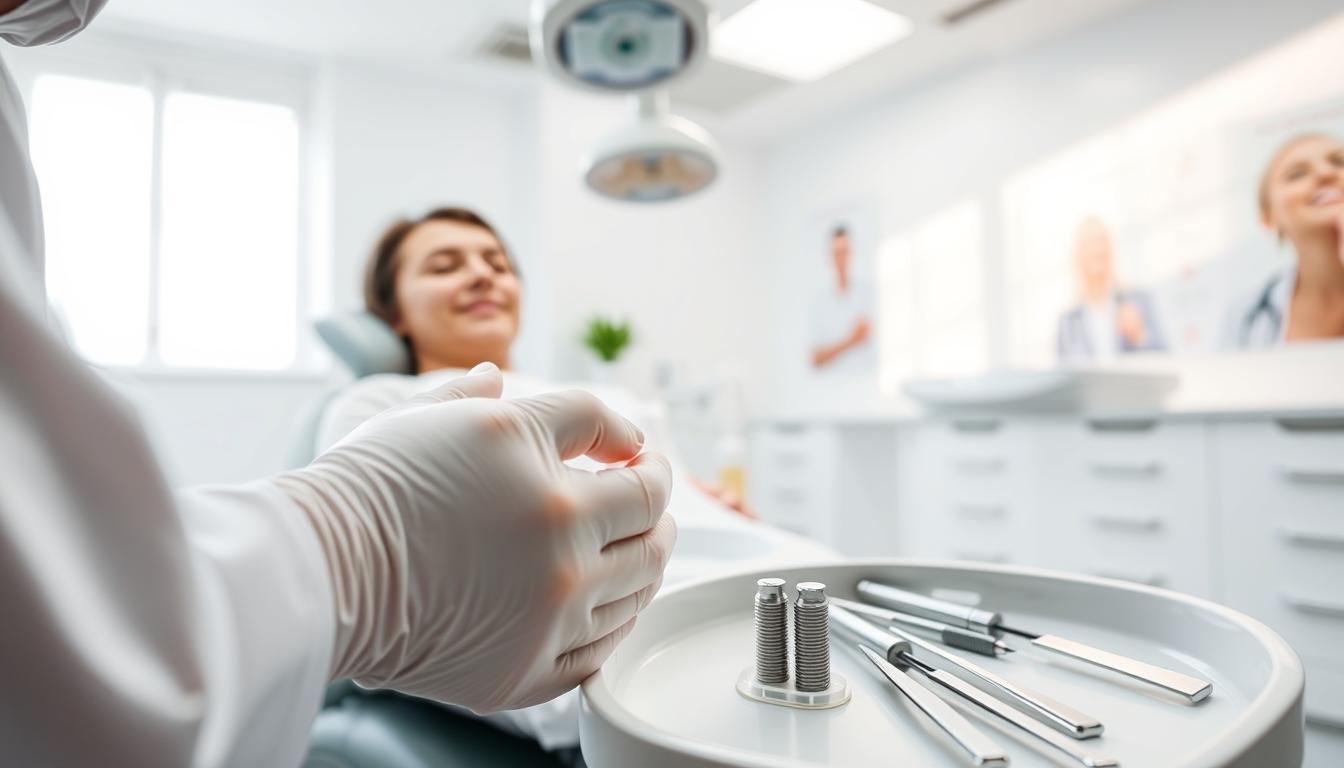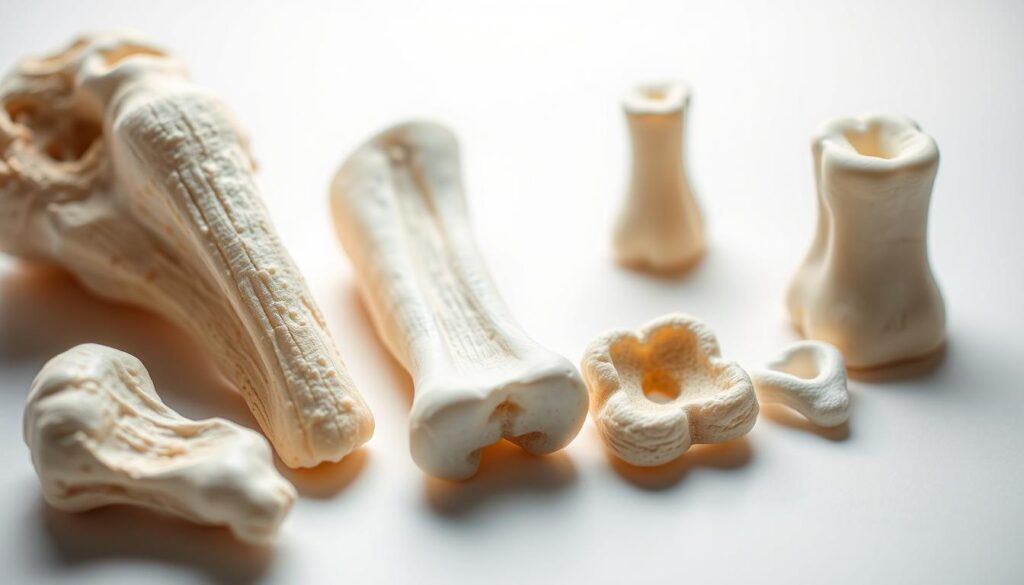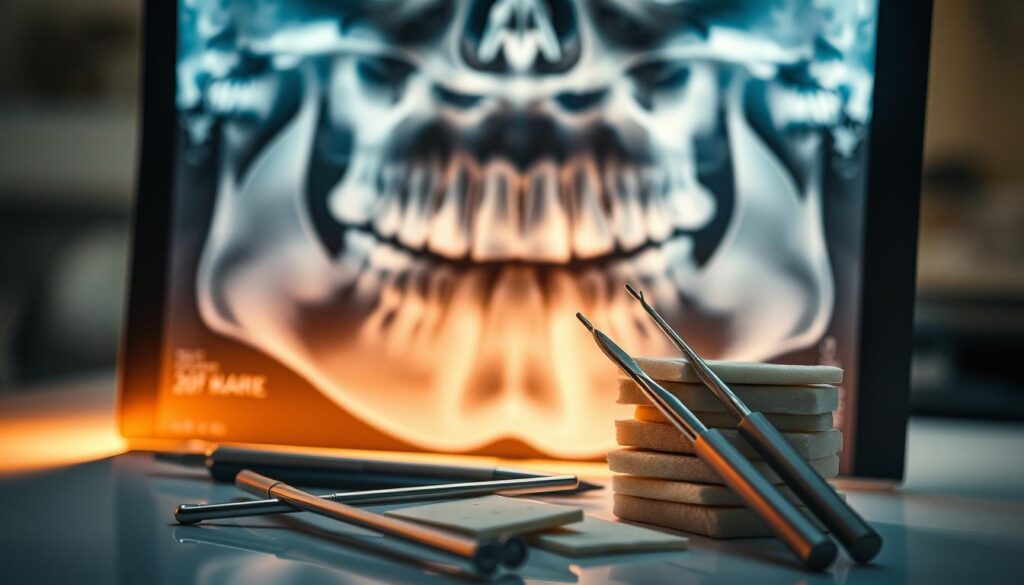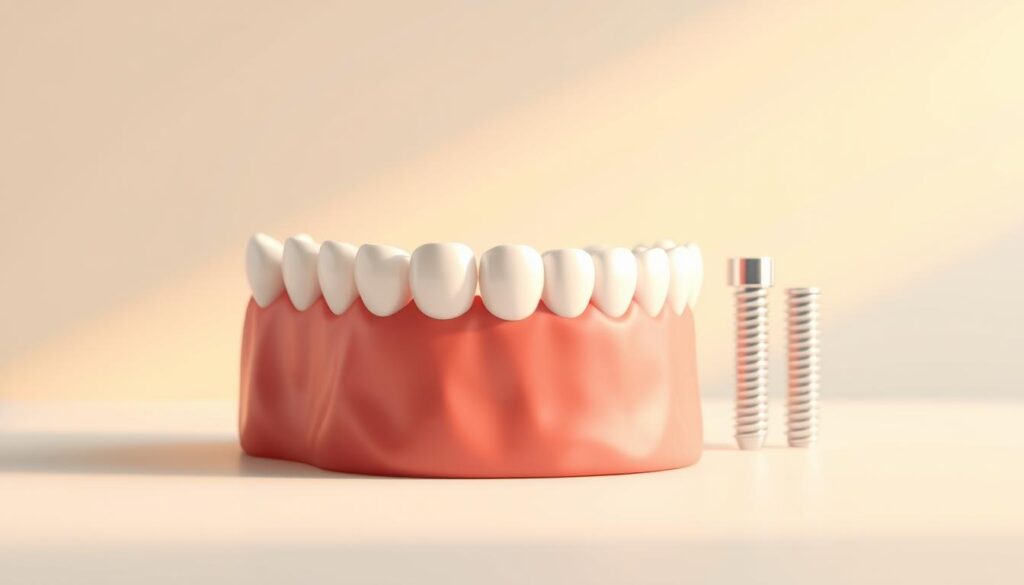What is a Dental Bone Graft?

The human jawbone has an amazing ability to heal itself. But, losing a tooth can speed up bone loss. In just a year without a tooth, about 25% of bone might vanish. This is when dental bone grafts become very important. They are vital for people who are losing jawbone and need dental surgery. These grafts help fix the damage caused by missing teeth and get the mouth ready for dental implants.
Dental bone grafting is key to keeping the jaw stable. It stops problems caused by bone loss and keeps the mouth healthy. This procedure is really important. Without it, jawbone loss can lead to bigger problems, like a change in how the face looks and poorer life quality. Doctors suggest dental bone grafts not just for missing teeth, but also to keep smiles healthy for a longer time.
Key Takeaways
- A dental bone graft is key for patients suffering from jawbone loss due to tooth loss.
- Essential for oral health, bone grafting preserves jaw stability and prepares the jaw for dental implants.
- The procedure significantly contributes to restoring oral function and enhancing life quality.
- Initial healing from a graft can take around a week, with full integration occurring over several months to a year.
- Addressing jawbone loss is critical for preventing further dental and facial structure issues.
Overview of Dental Bone Grafting Procedures
Dental bone grafting is key in dentistry. It’s vital for dental restoration and bone regeneration. This process rebuilds or augments jaw bone mass. Thus, it provides the support needed for dental implants and other procedures.
What goes into a dental bone graft is crucial to know. It involves transplanting bone tissue to aid bone regeneration. The graft might come from the patient’s own body, a donor, or synthetic materials that promote bone growth.
Definition of a Dental Bone Graft
A dental bone graft is surgery to increase jawbone volume. It’s done where the jawbone is too weak or needs to be stronger. This method supports future dental works. It also keeps the teeth and jaw in good shape.
Importance in Dental Health
Bone grafting’s role in dental health is huge. It stops teeth from moving and falling out. It keeps the mouth stable and ready for more dental work. Moreover, it helps keep a person’s face and jaws looking right. This affects their life quality big time.
| Type of Bone Graft | Source | Used In |
|---|---|---|
| Autograft | Patient’s own bone | Major bone regeneration |
| Allograft | Donor bone | Extensive dental procedures |
| Xenograft | Animal bone | Aesthetic dental restoration |
| Synthetic | Biocompatible materials | Minor bone repairs |
Indications for Dental Bone Grafting
Dental bone grafting is key for fixing jawbone health. It gets the mouth ready for other treatments, like tooth replacement. This part explains why bone grafting is vital after losing teeth and helps dental implants work well.
Tooth Loss and Its Impacts
Losing teeth does more than change how you look. It can cause big health issues if not taken care of. When teeth are gone, the jawbone gets weaker because it’s not being used. This weakness can mess up the jaw’s structure. It makes eating and talking hard, and can really change the way your face looks. Using a dental bone graft helps fight these problems. It gives the bone the help it needs to stay strong and healthy.
Preparation for Dental Implants
If you’re thinking about getting dental implants, your jaw needs to be strong enough. Dental bone grafts are key here. They’re needed if your jawbone is weak from not having teeth for a long time or if you have serious gum disease. A graft makes the jawbone strong. This is crucial so it can hold an implant properly, making the implant work well and last a long time.
For more info on tooth replacement and how dental bone grafts can help you, check out our detailed guide. Dental bone grafts are super important for good jawbone health. They help make sure other dental treatments, like implants, are successful.
Types of Bone Grafts
In the field of oral surgery, it’s important to know about the different bone grafts out there. Each type has its own benefits, designed to meet patients’ needs and improve surgery success.

Autografts: This method uses the patient’s own bone, often taken from the jaw, hip, or shin. Autografts are highly favored because they are highly compatible with the patient, helping new bone to grow and heal well.
Allografts: Allografts use bone from human donors, prepared from cadavers. They provide a good option for bone rebuilding without the drawbacks of taking bone from the patient’s own body.
Xenografts: Xenografts involve using animal bone, mostly from cows. They are an alternative when using the patient’s own bone isn’t possible. These grafts are specially treated to ensure they are safe and compatible.
Synthetic Grafts: Made of materials like calcium phosphate, synthetic grafts are created in labs. They offer another choice that sidesteps the need to take bone from a donor.
| Type | Source | Main Advantage |
|---|---|---|
| Autograft | Patient’s own bone | High compatibility and promotes effective healing |
| Allograft | Human donor bone | No need for additional surgical sites on the patient |
| Xenograft | Animal bone (bovine or porcine) | Readily available and fewer ethical concerns |
| Synthetic Graft | Biocompatible materials | Eliminates risk of disease transmission |
Every bone graft type is crucial for oral surgery, especially when it comes to dental implants and reconstructive work. By picking the right graft, oral surgeons can greatly improve bone healing. This means faster recovery and better results for patients.
The Dental Bone Grafting Procedure
The path to fixing your teeth with bone grafting is both high-tech and carefully done. It not only makes up for lost bone but also gets the site ready for more dental work. This work is needed for complete mouth health.
Every step of the bone grafting process is made to fit the patient’s needs. This ensures recovery goes well, and the graft works for a long time.
Initial Consultation and Planning
A dental surgeon first checks the jawbone with advanced scans. Then, they plan which graft is best, like a block bone graft, sinus lift, or a socket graft. The choice depends on where and how much bone is lost.
Surgical Procedure Steps
With anesthesia, the surgery is made to be as pain-free as possible. A cut is made to reach the bone for the graft. Then, the right graft material is put in place and secured. Finally, stitches are done to help healing.
Post-Operative Care and Recovery
After surgery, taking the right care steps is key to making the graft work. Instructions cover cleaning your mouth, managing pain, and taking antibiotics to stop infections. Check-ups are needed to see how well the graft and mouth are healing.
| Type of Graft | Material Used | Typical Application |
|---|---|---|
| Autograft | Patient’s own bone | Small to medium defects |
| Allograft | Donor human bone | Medium defects, periodontal regeneration |
| Xenograft | Animal bone | Larger defects, sinus lifts |
| Synthetic | Biocompatible materials | Extensive bone loss reconstruction |
Each graft material has its own benefits for the patient’s health and dental goals. By knowing this, patients and doctors can choose the best option for bone grafting.
Benefits of Dental Bone Grafting
Dental bone grafting goes beyond just supporting dental procedures. It’s key for bone regeneration, improving teeth stability, and future dental implants. It tackles bone loss and makes the mouth healthier. This means a better functioning mouth and a nicer smile.
This procedure boosts oral health by lessening bone deterioration risks. It strengthens the jaw for implants and keeps the face from looking sunken. This helps save the natural shape of your face.
Enhanced Oral Health
Improved oral health comes from successful bone regeneration. This safeguards against infections by making a stronger support for the teeth. A stronger foundation leads to better hygiene and a healthier mouth.
Improved Aesthetic Outcomes
Bone grafting can improve how you look. It brings back the jaw’s natural shape and supports the tissues underneath. This helps you look younger and feel more confident. And it makes dental implants work better.
Increased Success Rate for Implants
A good bone graft offers a strong base for dental implants. This means implants will be more secure and work like real teeth. This reliable solution improves life and is a long-term fix for missing teeth.
In short, dental bone grafting is crucial in modern dentistry for implants’ success. It’s important for bone growth and oral health. This makes it a vital choice for reconstructive dental work.
Risks and Complications of Bone Grafting
Dental bone grafts have changed restorative dental care, but they carry oral surgery risks. It’s crucial to address these risks for successful outcomes. Recognizing and dealing with risks is key to complication prevention.
Infections and slow healing can make recovery harder. Following doctor’s orders and keeping the area clean are vital. Graft rejection is rarer but needs quick action to fix.
- Infection and Healing Issues: After surgery, preventing infection is key. A clean environment and proper care reduce this risk.
- Graft Rejection or Failure: Sometimes, the body rejects the graft, seeing it as an intruder. This may need more treatment.
To avoid complications, patients should be proactive in their aftercare. Report any changes to your dental surgeon right away. This care is crucial for your dental bone graft to last.
Recovery Timeline After Bone Grafting
Knowing how long it takes to recover after a dental bone graft is key to good oral health. Let’s look at what happens right after surgery and during the longer healing period. Both stages are important to make sure the graft works well.
Immediate Post-Operative Phase
Right after the bone graft surgery, you might feel some discomfort. Doctors will give you pain relief options to help. They’ll also tell you how to care for your gauze dressing and when to take antibiotics to lower infection risks. Following their advice on what to eat and what to avoid is also crucial. This early care is essential for comfort and protecting the graft site as it starts to heal.
Long-Term Healing Process
The time it takes to fully heal from a bone graft can differ for each person. It depends on your health and the graft type. The pain and sensitivity at the graft site will lessen over weeks to months. During this period, it’s best to stay away from hard activities that might hurt the graft area. Going to the dentist regularly for check-ups and X-rays is a must. This helps check how well the bone graft is bonding, making sure it’s ready for any future dental work, like getting an implant.
Cost of Dental Bone Grafting
Knowing the dental bone graft cost is key if you’re thinking about getting dental restoration. The price of bone grafting varies a lot. It depends on the graft material and how complex the procedure is.

- Type of graft material: Choices include synthetic, cadaver, animal bone, and your own bone. Synthetic and animal bones cost between $400 to $1,200. Using your own bone can go over $2,000.
- Complexity of the procedure: The more complex the surgery, the higher the cost. Each part of the process, from consulting to follow-up, raises the price.
Insurance Coverage Considerations
- Insurance may cover bone grafts needed for medical reasons, but not for elective or cosmetic ones. Check your insurance to see if it’s considered necessary, which is key for insurance coverage.
- If insurance doesn’t cover the procedure, be ready to pay yourself. It’s important to get a cost estimate from your dentist to plan your budget.
Alternatives to Bone Grafting
Dental bone grafting is a top choice for bone augmentation needed for implants. Now, thanks to dental tech improvements, there are dental restoration alternatives. These options often require minimally invasive procedures. They make the process easier and the recovery quicker.
Ridge preservation techniques aim to keep the bone structure right after tooth extraction. This method helps avoid bone loss and makes future implant placement smoother. It involves filling the extraction site with bone or substitutes to keep the alveolar ridge’s height and density. This preserves the area for later restoration.
Mini dental implants offer a quick solution with less surgery. These implants are tinier and need less bone for placement. Mini dental implants can often be put in without prior bone grafting. This makes them popular for their simplicity and faster treatment time.

While these alternatives offer good paths for dental restoration, they depend on the patient’s specific oral health. A dentist must fully assess to find the best method. It must fit the individual’s dental goals and health. So, choosing these dental restoration alternatives should be done carefully and tailored to the person.
Preparing for Dental Bone Graft Surgery
To get ready for a dental bone graft, you need a thorough dental bone graft preparation. This starts with a detailed check-up before the surgery. It considers your whole medical history. This is key for a smooth surgery and healing.
Pre-Operative Evaluation
The pre-operative check is crucial for surgical readiness. Here, healthcare providers look over your full medical past. They focus on conditions or medicines that might affect the surgery. It’s important to talk about drugs, like blood thinners, that could change bleeding. Making changes to these drugs helps make the surgery safer and successful.
Patient Instructions
Patients get clear instructions to prepare for surgery day. If you’re getting general anesthesia, you might need to avoid eating for a while. You also need someone to drive you home, as you’ll be too drowsy to drive yourself. Getting ready for recovery at home is also essential. This means:
- Having someone with you for the first 24 hours after surgery
- Eating soft foods that don’t need chewing to help with healing
- Getting your pain and antibiotic prescriptions before surgery so you have them when needed
These steps help keep you safe during and after the surgery. They also create a good setup for your healing.
Understanding Bone Graft Success Rates
Looking into dental bone graft success rates is helpful for patients and doctors. A high success rate depends on key factors that improve oral surgery outcomes. We will look at these factors and how important follow-up care is.
Factors Affecting Outcomes
The success of dental bone grafts depends on many important points:
- The source and type of graft material used, like autograft, allograft, xenograft, or synthetics.
- The patient’s health status, as some health issues can affect graft healing.
- Lifestyle habits such as smoking or drinking alcohol can slow down healing.
These points are key in figuring out the dental bone graft success rate. They show why each patient needs a custom plan and approach.
Importance of Follow-Up Care
Good follow-up care is key to better oral surgery outcomes. After surgery, care usually includes:
- Check-ups to see how well the bone graft is doing.
- Regular scans to check the structure and find any problems early.
- Staying in touch with your dentist or surgeon to change the care plan if needed.
This careful follow-up helps the graft last longer and helps the surgery succeed more.
Knowing all this, patients can make smart choices and follow the advice they get after surgery. This is key to getting the best dental bone graft success rates and oral surgery outcomes.
Patient Experience and Testimonials
The journey through dental bone grafting profoundly changes lives. It greatly improves oral health and life quality. By reading about others’ journeys, future patients get a clear view of what to expect.
People talk about the good changes in function, feelings, and minds after getting dental bone grafts. Let’s look into real stories and recovery tales that show how this treatment can really transform lives.
After years of dental issues, bone grafting not only made my smile better. It also made me feel confident in social gatherings. – Recent Patient
Case Studies Overview: These offer detailed looks at before-and-after situations. They show with clear proof how bone density and oral health improve after the treatment. Reading these studies helps us see the clear wins of dental bone grafts.
Personal Recovery Accounts: These stories share the healing journey. People talk about their worries at the start, the healing day by day, and the lasting benefits. These stories give us a true feel of the emotional and physical healing journey.
| Timeframe | Symptom Improvement | Patient Satisfaction |
|---|---|---|
| 1 Month | Decrease in discomfort | Moderately satisfied |
| 3 Months | Significant pain relief and healing | Very satisfied |
| 6 Months+ | Full functionality restored, aesthetic improvement noted | Highly satisfied |
The table clearly shows how bone grafting helps patients over time. It backs up the great stories and feelings from dental bone graft patient experience and oral health testimonials. The process doesn’t just fix oral health. It also greatly improves the patient’s way of living and self-view.
FAQs About Dental Bone Graft
When talking about dental bone grafting, giving full, informed responses is key. We explore questions on dental bone graft FAQs and tooth replacement facts. This clarifies the process and what to expect.
People often wonder if they need a dental bone graft, if it’s safe, and what the results will be. These concerns are at the heart of deciding if a bone graft is the right choice for improving oral health. We answer these questions with reliable, fact-checked information.
This section isn’t just about answering common questions. It also fixes false beliefs, offering clear truths:
| Question | Answer | Fact Check |
|---|---|---|
| Is dental bone grafting painful? | Patients are administered anesthesia during the procedure, ensuring pain-free experience. | Anesthesia and post-operative pain management effectively minimize discomfort. |
| How long is the healing period? | Healing can vary but generally takes several months, influenced by personal health and adherence to care. | Following post-operative instructions closely can significantly enhance healing outcomes. |
| Are dental bone grafts safe? | When performed by experienced surgeons, dental bone grafts have a high success rate and minimal risks. | Correct surgical techniques and post-op care are crucial for success. |
| Can anyone get a dental bone graft? | Most people needing implants can undergo grafting, however, individual assessments are necessary. | Patient-specific factors must be considered to assure safety and effectiveness. |
It’s also important to separate myths from the truth about dental bone grafts:
Myth: Dental bone grafts are only for older adults.
Fact: Age doesn’t limit this procedure. It’s based on dental needs, not age.
Myth: Bone grafts are only taken from the patient’s body.
Fact: They can also come from donors, synthetic materials, or animals, depending on the case.
Myth: A dental bone graft is just for looks.
Fact: It’s a functional procedure aimed at improving tooth support for implants.
By tackling dental bone graft FAQs and giving true tooth replacement facts, we aim to help readers make wise choices about their dental care.
Finding a Qualified Dental Surgeon
Looking for top-notch oral surgery care, like a dental bone graft, needs careful thought. The skills of your dental surgeon are key to the treatment’s success and your smile’s health. It’s important to look into the surgeon’s background, training, experience, and specialties.
Checking if they are board certified is smart too. This shows they meet the highest care standards in their field.
What to Look for in a Specialist
When picking a dental surgeon, check their history of expert care. Look for high-level education, strong residency programs, and a dedication to learning. These signs show they know their stuff.
Seeing before-and-after pictures can also show you what to expect.
Resources for Research and Recommendations
Your search can start with recommendations from your dentist or other health pros. Reviews and testimonials let you hear straight from patients about their experiences.
To dive deeper, look at groups like the American Association of Oral and Maxillofacial Surgeons. They help you find top surgeons focused on the latest care. This careful research prepares you for a great bone graft outcome and a brighter smile future.
FAQ
What exactly is a dental bone graft?
Why are dental bone grafts important for oral health?
When is a dental bone graft indicated?
What types of bone graft materials are available?
What are the steps involved in the dental bone grafting procedure?
What are the benefits of getting a dental bone graft?
What risks are associated with bone grafting?
How long does it take to recover from a bone graft procedure?
How much does a dental bone graft cost?
FAQ
What exactly is a dental bone graft?
A dental bone graft is a surgery for replacing lost or damaged jawbone. It’s often needed for dental implants or to fix bone loss from oral health problems.
Why are dental bone grafts important for oral health?
They restore the jaw’s stability and integrity. This is crucial for oral function, dental implant success, and the aesthetics of the mouth and face.
When is a dental bone graft indicated?
It’s needed when someone has jawbone loss from tooth loss, gum disease, or for dental implant preparation.
What types of bone graft materials are available?
Available materials include autografts from the patient’s body, allografts from human donors, xenografts from animals, and synthetic options like calcium phosphate.
What are the steps involved in the dental bone grafting procedure?
First comes consultation and imaging, then anesthesia. An incision is made to place the graft and secure it. Finally, the incision is closed.
What are the benefits of getting a dental bone graft?
The benefits include preventing further bone loss and maintaining facial structure. They also improve oral function, enhance attractiveness, and increase dental work success rates.
What risks are associated with bone grafting?
Risks include pain, swelling, infection, blood clots, nerve damage, and anesthesia problems. There’s also a small chance of graft rejection.
How long does it take to recover from a bone graft procedure?
Initial healing might take a week. The full healing and bone integration can take months, based on individual factors.
How much does a dental bone graft cost?
Costs range widely. Synthetic or donor bone grafts might cost $400 to $1,200. Autografts might be over $2,000. Insurance coverage varies. Be ready for potential out-of-pocket costs.
Are there alternatives to bone grafting?
Yes, alternatives include ridge preservation to prevent bone loss after tooth extraction and mini implants that might not need grafting.
How should I prepare for dental bone graft surgery?
Prepare by getting a pre-op evaluation, discussing meds, fasting, arranging a ride home, and getting ready for home recovery.
What factors affect the success rate of dental bone grafts?
Success depends on the graft material, the patient’s health, lifestyle habits like smoking, and following post-op care and check-ups.
Can I see before and after case studies or testimonials from patients who have had a dental bone graft?
Yes, you can find patient testimonials and case studies online. They show how bone grafts have transformed people’s oral health and looks.
What should I know when looking for a qualified dental surgeon?
Look at the surgeon’s experience, oral surgery specialization, credentials, and certification. Seek referrals, read patient reviews, and check their standard of care.
,200. Autografts might be over ,000. Insurance coverage varies. Be ready for potential out-of-pocket costs.
Are there alternatives to bone grafting?
Yes, alternatives include ridge preservation to prevent bone loss after tooth extraction and mini implants that might not need grafting.
How should I prepare for dental bone graft surgery?
Prepare by getting a pre-op evaluation, discussing meds, fasting, arranging a ride home, and getting ready for home recovery.
What factors affect the success rate of dental bone grafts?
Success depends on the graft material, the patient’s health, lifestyle habits like smoking, and following post-op care and check-ups.
Can I see before and after case studies or testimonials from patients who have had a dental bone graft?
Yes, you can find patient testimonials and case studies online. They show how bone grafts have transformed people’s oral health and looks.
What should I know when looking for a qualified dental surgeon?
Look at the surgeon’s experience, oral surgery specialization, credentials, and certification. Seek referrals, read patient reviews, and check their standard of care.


